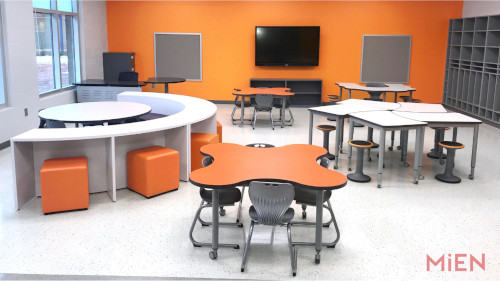Identified by EDUCAUSE as a top strategic technology, active learning classrooms (ALCs) go beyond just outfitting learning spaces with technology. These engaging, dynamic spaces provide new pedagogical opportunities, support active learning, and help students develop relevant skills.
In 2020, the pandemic forced rapid adoption of school-based technology within a compressed time frame. Most students now have mobile devices, while schools have been teaching in a rotation of remote, in-person, and hybrid learning models. And, more district administrators are using blended learning as they infuse technology with more flexible learning models.
The traditional classroom model has been turned on end, with the arrangement of desks and front-of-the-classroom focus becoming obsolete and unnecessary. In its place are dynamic, flexible, and mobile learning spaces that support student-centered teaching, collaboration, and engagement.
These active learning spaces represent a significant shift from traditional pedagogy and focus instead on creativity, collaboration, critical thinking, and communication. They also support modern skillsets like computational thinking, growth mindset, resilience, and leadership—all of which are considered critical to students’ academic and career success. In pursuit of these skills, students will also develop highly-valued social skills that allow them to engage and collaborate with others successfully.
Infusing flexibility into the classroom
Today’s flexible learning environments use movable walls and modern, modular, multi-use furniture to reconfigure learning spaces based on the learning objective. Desks, tables, and chairs on casters are easy to move and quickly reshape the learning space to accommodate quiet activities, small group, or whole group activities. These flexible options boost student engagement and improve outcomes by giving students voice and choice about where and how they learn best.
Flexible learning environments also allow students to create and collaborate with peers; actively engage in the creative learning process; and reflect on their learning. Teachers are able to support a variety of different learning styles, give students a space for reflecting on their learning, and can also better reflect on the diversity of their classrooms.
To create an active learning space that engages all learners, instruction should be contextually and culturally relevant for all learners and be differentiated to meet the diverse learning needs within the classroom. The space should also:
1. Help students succeed. Creating new learning environments and supporting new pedagogy, curriculum, and personalization with technology will drive higher levels of student engagement and academic achievement while allowing students to work at their own pace.
2. Be flexible. Flexible functionality of redesigned learning spaces allows reconfiguration of the space throughout the day depending on the learning objective or whether students need to work alone, in pairs, or in a small group.
3. Prepare students for the future. These responsive learning spaces allow brainstorming, collaboration, and a variety of meeting configurations that reflect the campuses and workplaces of today.
4. Promote independent learning. Active learning spaces give students voice and choice to facilitate how they learn best and promote ownership of their learning.
5. Teach a variety of skillsets. The activities in active learning spaces foster the development of the 4Cs (critical thinking, creative thinking, communicating, and collaborating) and other technical and social skills that students need for successful learning outcomes.
Supporting the modern classroom
While retrofitting every traditional classroom into an active learning space may be unrealistic, there are ways to create more flexible spaces within the classrooms, libraries, and student gathering spots that students frequent every day. Look for innovative furniture that creates spaces to promote student engagement and creative thinking while reflecting a school’s culture, along with designs that are flexible, adaptable, and incorporate mobile and collaborative features that support today’s school and learning concepts.
- The evolving requirements of a K-12 school network - April 24, 2024
- A bungled FAFSA rollout threatens students’ college ambitions - April 24, 2024
- How digital tools and AI can enhance social studies - April 23, 2024

